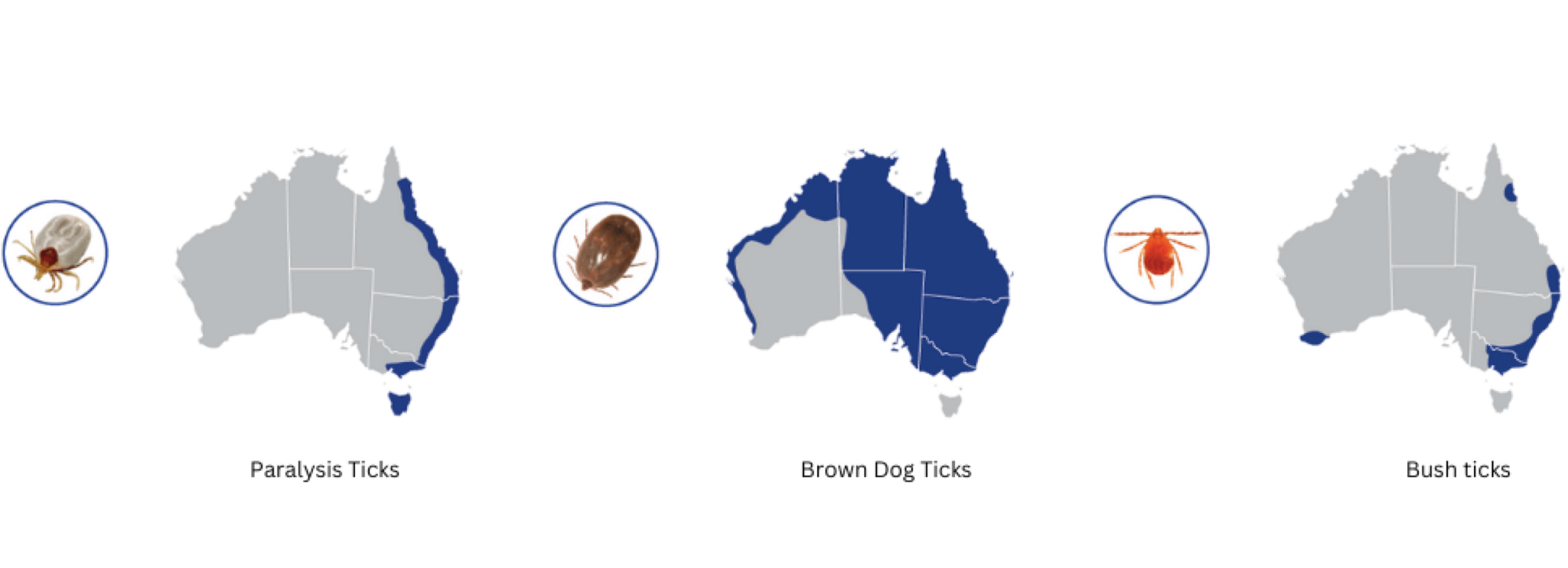Last Updated: 07/05/2025
Do Tick Collars Work?
Interested in tick collars for your dog? See our vets recommendation on best tick collars and whether it is enough to keep your dog protected.
Author: Dr Elise Barry BVSc (Hons)
Reading Time: 14 minutes - short read
Ticks are a pesky pest for dogs and cats and in many regions the tick season has continued throughout Winter and is worsening as the weather continues to warm up.
There are three main types of ticks: brown, bush and paralysis. Brown and bush ticks are usually not life threatening but will irritate your pet where they latch on to feed, and can transmit other diseases such as Ehrlichiosis.
Paralysis ticks, however, are the main concern in Australia. They are venomous and will quickly cause paralysis and even death if left untreated. Paralysis ticks are commonly found on the East coast of Australia.
With an ever-growing number of tick preventatives for pets released each year, it's not surprising that Australian pet owners are often left feeling a little confused.
Which tick prevention is actually the most effective? Is a tick collar enough?
Contents:
Pros and Cons of Tick Collars

Pros

Affordable

Easy to use, no tablets or liquids

Long lasting compared to monthly treatments
Cons

Not 100% effective against paralysis ticks

Effectiveness can be reduced by water exposure

Not suitable for teething puppies or sick animals

May take time to fully penetrate thick coats which can reduce effectiveness initially
Collars do not provide 100% protection
Despite the high protection from tick collars the products do warn that one female tick is enough to make a dog unwell or worse. Collars should therefore not be fully relied upon for protection. Kiltix carries a warning on its label reminding pet parents that "this product is not fully effective against paralysis ticks".
Daily tick searches and removal of ticks is recommended for all pets in paralysis tick prone areas, even when prevention is used.
Tick paralysis is often fatal, which means using a preventative is essential if you live in a tick area or are planning to visit one. An attached paralysis tick releases a deadly toxin which causes paralysis. This generally begins with a voice change, weakness in the back legs and trouble blinking or swallowing. Without treatment these symptoms will progress to paralysis of the respiratory muscles, resulting in death.
What to do if you find a tick on your pet: take them to your veterinarian immediately for examination. They may require tick antiserum and supportive care. It's important not to assume that the problem is 'gone' as soon as the tick has been removed. Even after a tick has been removed, your pet's symptoms may worsen and develop further because the venom is still present in their system.
Want to know more? Read our guide to Ticks in Dogs & Cats.
Tick Collars Compared

The active ingredients, duration of action, waterfastness and suitablity of each tick collar can vary, so check out our table below for a comparison of some of the tick collars currently available for dogs and cats.
Table Component Missing
*Tick collars should not be used in puppies until they have finished teething as chewing or eating the collar can result in serious illness.
So is a collar enough?

The answer is, it depends. While in some cases a tick collar may provide adequate protection for your dog, it depends on a number of factors including the area you live in, time of year and your pet's lifestyle.
For dogs living in non-east coast areas at risk of brown dog ticks, a Seresto Collar is ideal as it repels brown dog ticks before they have a chance to attach and potentially transmit Ehrlichiosis.
For dogs along the east coast at risk of paralysis ticks, we recommend using isoxazoline-based products such as Simparica, Bravecto, Credelio or Nexgard.
For dogs living along the east coast in areas at risk of both paralysis ticks and brown dog ticks, we recommend an isoxazoline-based product (as above) as well as a repellant product such as Seresto.
For cats who spend time outdoors, we recommend tick prevention using isoxazoline-based products such as Bravecto or Revolution Plus. While Brown dog ticks pose minimal risk to cats, if you live in an area where Brown Dog ticks are active, we recommend speaking to your vet regarding additional tick control for your cat.

Approximate distribution of ticks based on confirmed reports (Barker & Barker 2021 (in press). "Ticks of Australiasia". Magnolia. Source: Nexgard Tick Check
Weigh up the pros and cons of tick collars and read product instructions closely. Remember it is always safest to check with your vet or ask a Pet Circle Vet about the best tick prevention to suit your dog or cat's needs.
Further Reading
Want to know more? Check out our Discover Page for more tips from our expert vets on keeping your pets happy and healthy.